تتطلب الملاءمة والإنتاجية للمحترفين في أي صناعة مواكبة التغييرات والتطور مع الصناعة مع ارتفاعها إلى أعلى المستويات. إن إدارة المشاريع المجال يستدعي ذلك وأكثر، ولهذا السبب نقدم لك هذه القائمة الثاقبة من مصطلحات إدارة المشاريع لمساعدتك في ذلك!
أ - هـ: من الإدارة الرشيقة إلى إدارة القيمة المكتسبة
Agile
لا ترضى بأي شيء مختلف إذا كنت بحاجة إلى نهج إدارة المشروع الذي يسمح بملاحظات العملاء في الوقت الفعلي في كل مرحلة من مراحل تطوير المشروع. تدعم الأجايل التعاون والتنظيم الشخصي وقابلية التوسع حسب احتياجات المشروع وأصحاب المصلحة. وهو يقسّم المنتجات المعقدة والكبيرة إلى أجزاء قصيرة وقابلة للإدارة تسمى سبرينت سكرمز.
إدارة المشاريع الرشيقة إدارة المشاريع الرشيقة هي طريقة سهلة التكيف لإدارة المشاريع يستخدمها مطورو البرمجيات ومديرو المنتجات. وهي تقسّم المشروع إلى مراحل تتطلب مراجعة دورية للمهام بناءً على ملاحظات العميل. كما أنها تجلب أسلوبًا تكراريًا ومرونة في مساعي إدارة المشروع، مع التركيز على رضا العملاء والتعاون.

قم بسحب أي مهمة وإفلاتها في العمود التالي لتحديث حالتها تلقائيًا باستخدام طريقة عرض لوحة تشبه لوحة كانبان في ClickUp
تخطيط المشاريع الرشيقة
"ليس هذا ما كنت أفكر فيه!" لتجنب ردود فعل العملاء هذه، فكر في استخدام منهجية المشروع القابلة للتطوير التي تقسم المشروع إلى سباقات سريعة مدتها أسبوعان. من الذي لا يحتاج إلى أوقات إنجاز قياسية مع التغذية الراجعة والشفافية وإدارة الوقت و ضمن الميزانية ?
مخطط
عندما ينشأ ارتباك في تفسير المصطلحات في البرمجة، ألقِ اللوم على المخطط. المخطط عبارة عن مجموعة من الأفكار المترابطة والمختلفة بمهارة. يشير مصطلح إدارة المشروع أيضاً إلى تمثيل بياني لتصميم البرمجيات. وهو يعطي عرضاً مرئياً موجزاً لمشروع أو مفهوم معقد.
دراسة حالة
دراسة الحالة هي عبارة عن قصة متعمقة حول مشاكل الحياة الواقعية وتطبيق المفاهيم في المجتمع. ستجد العديد من الحكايات التي تعطي جانباً عملياً للمفاهيم النظرية لمصطلح إدارة المشاريع هذا.
مؤشر أداء التكلفة
عند تقييم أداء مشروع ما فيما يتعلق بالميزانية، توضح نسبة مؤشر أداء التكلفة ما إذا كان المشروع فعالاً من حيث التكلفة. هل هو في حدود الميزانية أم أقل من الميزانية أم يتجاوزها؟ المعادلة هي CPI = القيمة المكتسبة (EV) / التكلفة الفعلية (AC).
إدارة المشاريع ذات السلسلة الحرجة
هو نهج إداري يدمج مجموعة المهام والجداول الزمنية والموارد المطلوبة لضمان إكمال المشروع في الوقت المناسب في حدود الميزانية. وهو يقيّم قدرة الفريق على إكمال المشروع بناءً على الاحتياجات والموارد المتاحة له.
طريقة المسار الحرج
يحدد المسار الحرج الأساسيات المطلوبة لإكمال مهمة ما. ويذهب كل ذلك إلى تحسين الكفاءة من خلال التخلص من الأنشطة غير ذات الصلة والمضيعة للوقت . يمكن تخصيص المزيد من الموارد للمهام الحرجة لتسريع إنجاز المشروع إذا لزم الأمر.
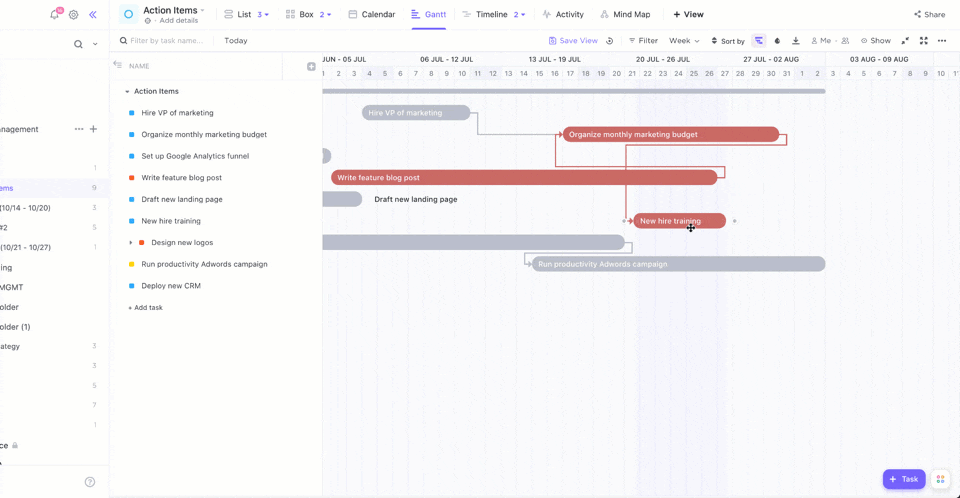
يتحقق المسار الحرج من جميع المهام على المخطط ويحدد المجموعة التي ستؤثر على الموعد النهائي الإجمالي للمشروع إذا تم تعديلها
عامل النجاح الحرج
67% من المشاريع تفشل بسبب سوء إدارة الوقت أو المال. يبتعد مديرو المشاريع الأذكياء عن المشاكل من خلال صياغة خطة استراتيجية. تشكل عوامل النجاح الحاسمة الخطة الاستراتيجية أو خطة العمل التي تضمن نجاح المشروع.
يجب على مديري المشاريع تحديد العوامل الحاسمة المميزة مثل المتطلبات المعالم المنجزات والبرمجيات وخطط التواصل المفتوحة
التبعيات
تحدث العلاقات المتبادلة في إدارة المشروع عندما تعتمد مهمة أو حالة أو حدث ما على إكمال مهمة سابقة أو مهمة تالية. وتعطي التبعيات أولوية التوجيه على العلاقات بين المهام وترتيبها للحفاظ على سير عمل مستقر.

كيفية إضافة تبعية إلى علاقة في ClickUp
إدارة القيمة المكتسبة
تتطلب إدارة المشروع منهجية كمية للتقييم المستمر لتقدم المشروع. توفر إدارة القيمة المكتسبة معايير لتقييم تقدم المشروع مقابل الجدول الزمني ومخصصات الميزانية. ويستخدم مديرو المشاريع هذه المقاييس للتنبؤ بالمشروع والتكيف مع الفروق الناشئة.
F-L: التتبع السريع للمهلة الزمنية
التتبع السريع
في بعض الأحيان يتأخر المشروع عن الجدول الزمني. ألقِ اللوم على الإرهاق ونقص الموارد وعدم وضوح الأهداف وسوء التواصل في ذلك، ولكن هذا لا ينفي ضرورة تحقيق المعالم الرئيسية. وإلا كيف، ولكن عن طريق التعقب السريع للمشروع باستخدام حيل ضغط الجدول الزمني! وبالتالي، فإن التتبع السريع ينطوي على تكتيكات مثل تداخل المهام أو تنفيذها بالتوازي لإكمال المشروع بحلول تاريخ التسليم الأصلي.
مخطط انسيابي
كأداة لحل المشكلات، فهو يربط بين أجزاء المشروع ويعزز تدفق المعلومات ومعالجتها. بالإضافة إلى ذلك، فإن برنامج المخطط الانسيابي قد يخدم وظائف أخرى، مثل تبسيط المفاهيم المعقدة لتسهيل تصورها وفهمها.
العملية/التطوير التدريجي التكراري
يتضمن نموذج التطوير التكراري للبرمجيات تكرار الأنشطة في دورات أو تكرارات. وهو يؤدي إلى إنتاج نسخة جديدة من البرنامج حتى يتم تطوير الإصدار المطلوب أو الأفضل.
تقسم الطريقة التدريجية مهمة تطوير البرمجيات إلى أجزاء صغيرة. ويؤدي تطوير كل جزء إلى تحسين الجزء السابق بحيث يتقدم المشروع على مراحل. تجمع العملية التكرارية التزايدية بين هذين النهجين التكميليين بحيث تحدث التحسينات على المشروع في كل مرحلة من مراحل التطوير وليس بطريقة خطية.
لوحة كانبان
A لوحة كانبان تتيح لك رؤية المهام المعلقة والجارية والمكتملة في الوقت الفعلي. تقسم طريقة كانبان المشروع إلى أجزاء من المهام. في هذه الطريقة، يمكنك استخدام الملاحظات اللاصقة أو بطاقات كانبان لتمثيل المهام بصريًا.
توفر لوحة كانبان معلومات تساعد المديرين على التخلص من المهام غير ذات الصلة والمهدرة. كما أنها تجعل الفرق عالية الإنتاجية من خلال زيادة تركيزها على العناصر الحاسمة في عملية التطوير.

تساعد لوحة كانبان على تصور عملك قيد التنفيذ وزيادة الكفاءة إلى أقصى حد
مؤشرات الأداء الرئيسية
تتطلب الإدارة الفعالة للمشروع مخططًا واضحًا للأهداف أو الغايات. فكيف يمكنك ترتيبها وتقييمها حسب الأولوية؟ هنا يأتي دور مؤشرات الأداء الرئيسية من خلال توفير مقاييس لقياس أدائك في تحقيق الأهداف أو الغايات الرئيسية.
يتتبع المؤشر الأداء في الأهداف الرئيسية فقط. تختلف مؤشرات الأداء الرئيسية باختلاف ما تعتبره الشركة المؤشر الرئيسي لقياس نجاحها.
مهلة التنفيذ المهلة الزمنية يحدد الوقت الذي يستغرقه تنفيذ الطلب بعد أن يقوم العميل بتقديمه. وهو يوفر ريادة في أداء الأعمال لأنه ينعكس بشكل مباشر على مخرجات العمل ورضا العملاء بغض النظر عن مرحلة أو طبيعة المشروع. وهو يدور حول:
- إنشاء المنتج أو تطويره: المدة التي يستغرقها المنتج المطلوب لدخول السوق
- إدارة سلسلة التوريد: وقت تقديم الطلب حتى وصول المنتج إلى العميل
- إدارة المشروع: المدة الإجمالية لإتمام جميع المهام التي يتطلبها المشروع
م - ب: جدول أعمال الاجتماع إلى الجدول الزمني للمشروع
جدول أعمال الاجتماع
يساعد التواصل المفتوح والفعال في اجتماعات الفريق الأعضاء على إبقاء الأهداف والغايات في بؤرة التركيز. يتطلب تحقيق الاستفادة القصوى من الاجتماع جدول أعمال الاجتماع ، وهو عبارة عن الخطوط العريضة للقضايا المزمع مناقشتها في الجلسة. إن وجود جدول أعمال بسيط للاجتماع أو جدول أعمال رسمي يجنبك إهدار الوقت في أمور دنيوية والخروج عن الموضوع وعدم معالجة القضايا الرئيسية للمشروع.
يجب عليك استشارة أعضاء الفريق الآخرين في إعداد جدول أعمال الاجتماع للسماح لهم بالاستعداد. بالإضافة إلى ذلك، يجب أن يعرفوا ما يجب عليهم فعله قبل الاجتماع وبعده وأدوارهم في الاجتماع.
محضر الاجتماع
بعد حضور الاجتماع، قد تغادر الاجتماع ومعك قائمة شخصية بالنتائج التي استخلصتها من المناقشة والعروض التقديمية. هذه ملاحظات غير رسمية أو ملاحظات الاجتماع. وهي ليست محاضر اجتماعات. محاضر الاجتماعات عبارة عن نسخة رسمية من ملاحظات الاجتماع، ويتم اعتمادها بإجماع جميع من حضروا الاجتماع بإجماع الحاضرين باعتبارها محضراً صحيحاً لكل ما تم مناقشته أو حدث في الاجتماع.
معلم
يحتوي كل مشروع على إنجازات رئيسية أو نقاط مرجعية تستخدم لتحديد المراحل الرئيسية في تطوير المشروع . وبالتالي، فإن المعلم يشير إلى حدث مهم في تطوير المشروع . يساعد الفريق على تتبع تقدمه مقارنة بأهدافه.
وبدون ذلك، سيكون من المستحيل الحصول على منظور حول المواعيد النهائية أو هيكلة المشروع. يستخدم المديرون المختلفون عوامل مثل تواريخ الاستحقاق المحددة وفقًا للجدول الزمني للمشروع أو الحصول على موافقات أصحاب المصلحة في المشروع لوضع معالم الإنجاز.

كيفية إضافة علامة فارقة في ClickUp
الخرائط الذهنية
إذا كنت تتخيل شجرة ذات فروع متعددة، فأنت في طريقك لفهم مفهوم الخريطة الذهنية. A الخريطة الذهنية تحدد مفهومًا رئيسيًا بأفكار أو مفاهيم فرعية ذات صلة تنبثق منه. وهي مفيدة في تخطيط وإدارة المشاريع عن بُعد وداخل الشركة. كل فرع من فروع الخريطة الذهنية يحتوي على كلمة رئيسية أو صورة تتدفق منه. تظهر الصورة بأكملها بألوان مختلفة لتحديد كل قسم. وهي تربط الأفكار بالمفهوم الرئيسي لحل المشكلات والتنظيم والعصف الذهني والتخطيط.
تنظم الخرائط الذهنية المعلومات في تسلسل هرمي لإظهار العلاقات
بيان المهمة
إذا طُلب منك أن تصف شركتك، فسيكون لديك الكثير لتقوله: صلتها بالصناعة أو المجتمع، وموقعها الجغرافي، وعملياتها، وهدفها، وطبيعة خدماتها أو منتجاتها، وعملائها، وغير ذلك الكثير. لخص ذلك في جملة واحدة، وسيكون لديك بيان مهمة شركتك! يعتبر بيان المهمة الجيد نقطة بيع جيدة عندما يتعرف على احتياجات عملائها أو الحلول التي تقدمها.
الهدف
ليس من الضروري أن تكون تنمية الأعمال أو تنفيذ مشروع ما أمرًا معقدًا إذا كان لديك هدف واضح. ويشمل الهدف أو الغاية ما يلي الأهداف التي تحددها لتوجيه مهامك أو عملياتك . يمكنك من خلاله تعزيز المساءلة، وتحديد المشاكل وحلها، والتركيز على المجالات التي تتطلب التحسين. وهو يدعم رؤية شركتك كما وردت في بيان المهمة. إكمال هدفك يحقق هدفك.
أنشطة المشروع
نشاط المشروع عبارة عن مهمة ذات مهام فرعية داخلها. يؤدي إكمال المهام الفرعية إلى إنجاز تلك المهمة الأساسية أو المهمة الرئيسية. على سبيل المثال، في الحالة التي تكون فيها المهمة الأساسية هي إنشاء عرض تقديمي، فإن المهام الفرعية تشمل: جمع المحتوى، وتصميم مجموعة الشرائح، والمراجعة مع أصحاب المصلحة الرئيسيين، وبناء الناتج النهائي.
ميزانية المشروع
A ميزانية المشروع تعطي إجمالي التقديرات أو النفقات أو التكاليف المتوقعة المطلوبة لإكمال المشروع خلال فترة محددة. وهي تسلط الضوء على التكاليف في كل مرحلة من مراحل دورة حياة المشروع. يمكن أن يؤدي سوء التقدير في متطلبات الميزانية إلى حدوث عجز أو سوء استخدام للأموال مما قد يعيق الإنجاز. تعتبر ميزانية المشروع عاملاً في الموافقة على المشروع الذي يقيس الأداء.

إجراء حسابات بين الحقول في مهمة باستخدام كل من الصيغ البسيطة والمتقدمة
منجزات المشروع
المنجزات هي نتائج الأنشطة التي يتألف منها المشروع. وهذا يعني أن مخرجات المشروع ليست النتيجة النهائية للمشروع. مخرجات المشروع هي الخدمات أو المنتجات التي يتم الحصول عليها من المشروع وتسليمها إلى العميل. يجب أن يحظى الناتج بموافقة أصحاب المصلحة وأن يلعب دوراً محدداً في أهداف المشروع.
أهداف المشروع
عندما يأتي المشروع إلى حيز التنفيذ، فإنه يبدأ بـ بيان واضح للنتيجة المرجوة منه . تحدد هذه البيانات أهداف المشروع من خلال ذكر الإسقاط العام لما سيحققه المشروع. إذا كانت أهداف المشروع تحدد النتائج فقط، فإنها تصبح غامضة.
يمكنك مواجهة الغموض من خلال تضييق نطاقها إلى جوانب محددة من المشروع مثل الأهداف الزمنية وأهداف الأداء وأهداف الموارد. لذا، إذا كنت تخطط للحصول على 20 عميلًا جديدًا في العام المقبل، يجب عليك تقييم ومعرفة ما إذا كان هدفك قابلًا للتحقيق ومحددًا زمنيًا وقابلًا للقياس الكمي وواقعيًا ومحددًا لكي يكون هدفًا صالحًا للمشروع.
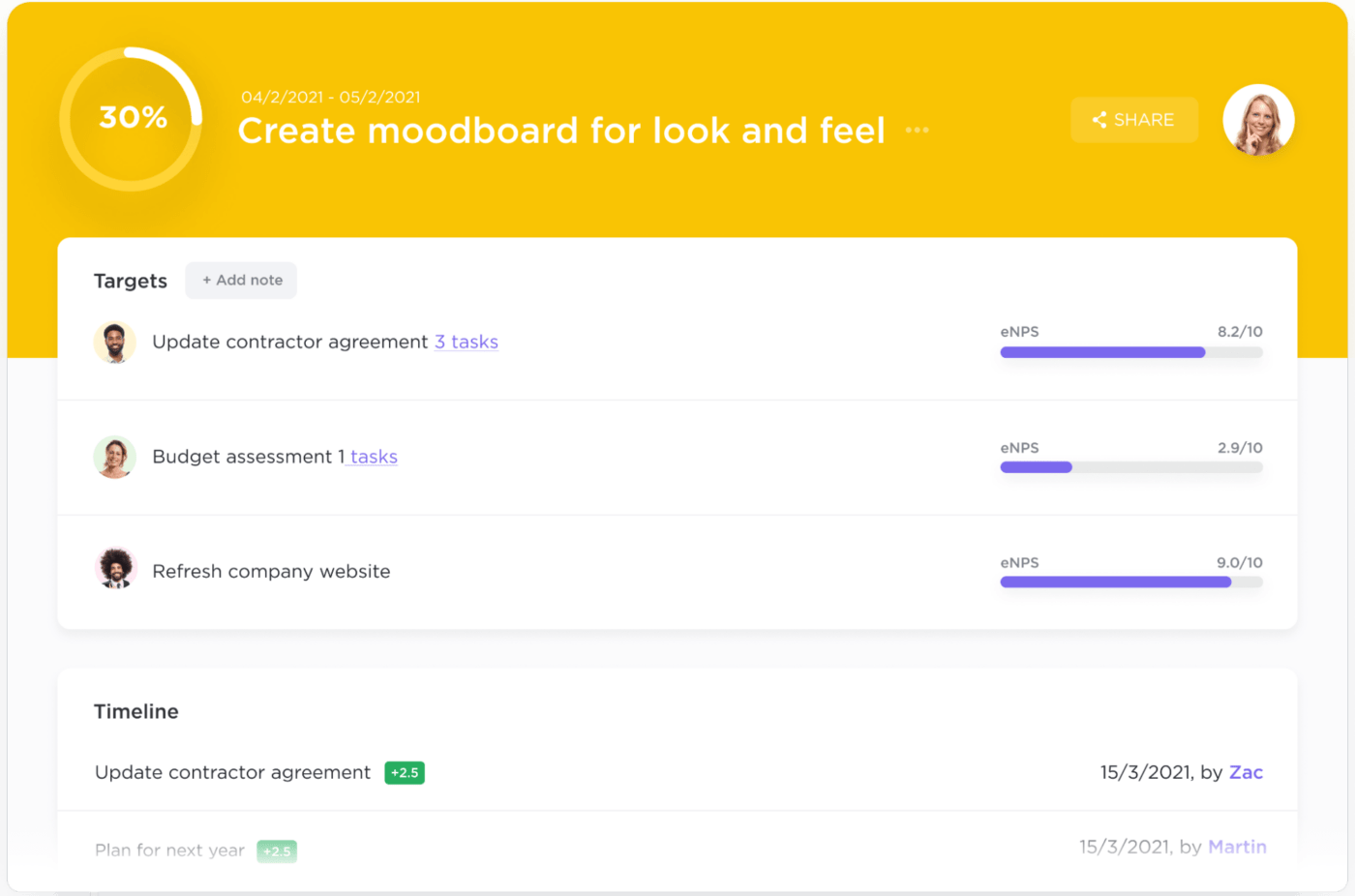
يعطي هدف المشروع سياقاً شاملاً لما سينجزه المشروع
دورة حياة المشروع
نسمع أن كل شيء تقريباً له بداية ونهاية. وهذا يشمل مشروعك. A دورة حياة المشروع هي العملية التي يتبعها المشروع من بدايته إلى نهايته. وهي فكرة شاقة بالفعل، إذا كنت تعتقد أنها تعني إدارة جميع الجوانب التي تتكون منها دورة حياة المشروع: المنجزات، والفريق، والعملية، واحتياجات العملاء.
معهد إدارة المشاريع
تمنح هذه الجمعية غير الهادفة للربح عضوية احترافية لمديري البرامج ومديري المشاريع. بالإضافة إلى ذلك، يمنح معهد إدارة المشاريع أعضاءه الاعتماد المهني لإدارة المشاريع المعترف بها في جميع أنحاء العالم. يوفر هذا الاعتماد لأصحاب العمل والعملاء الثقة في مؤهلات المحترف في إدارة المشاريع. وبالنظر إلى عدد الموارد التي يتم إغراقها في المشاريع، سيكون من المفيد التأكد من وجود محترف معتمد على رأس فريقك.
مدير مشروع
هو الشخص المخول بمسؤولية تخطيط المشروع وتوجيهه حتى اكتماله من خلال ضمان الالتزام بالمواعيد النهائية والميزانية والتسليمات. وهم توفير التوجيه لدورة حياة المشروع من خلال استغلال الموارد لتحقيق أقصى قدر من الكفاءة، وخفض التكاليف مع زيادة الإيرادات، وتشكيل المهمة والأهداف العامة للمنظمة. وتعتمد الواجبات المحددة لمدير المشروع على طبيعة مجال عمله وأنواع المشاريع المعنية.
أهداف المشروع
الأهداف والغايات هي مصطلحات مختلفة لإدارة المشاريع. أهداف المشروع هي بيانات محددة لما يجب على فريقك تحقيقه، والنتيجة المرجوة من تحقيق الأهداف هي الهدف. أهداف المشروع تتطلب استراتيجية موجزة ووسيلة أو أدوات لقياسها مثل لوحة متابعة التقدم المحرز لإبقاء المشروع على المسار الصحيح.
إدارة محفظة المشاريع إدارة محفظة المشروع هي مهمة في إدارة المشاريع تنطوي على اختيار وترتيب ومراقبة مشروع أو برنامج ما وفقًا لقدراته وأهدافه. وهي توفر قيمة من خلال اختيار المشاريع، ومواءمتها مع الخطة الاستراتيجية للشركة، والاستفادة المثلى من الموارد المحدودة لتحقيق التآزر بين المشاريع.
من خلال هذه التدابير، لن تنخرط المؤسسة في مشاريع غير ذات صلة أو مشاريع كثيرة جدًا مما يؤدي إلى الفشل بسبب الافتقار إلى الإدارة والتنسيق المناسبين.
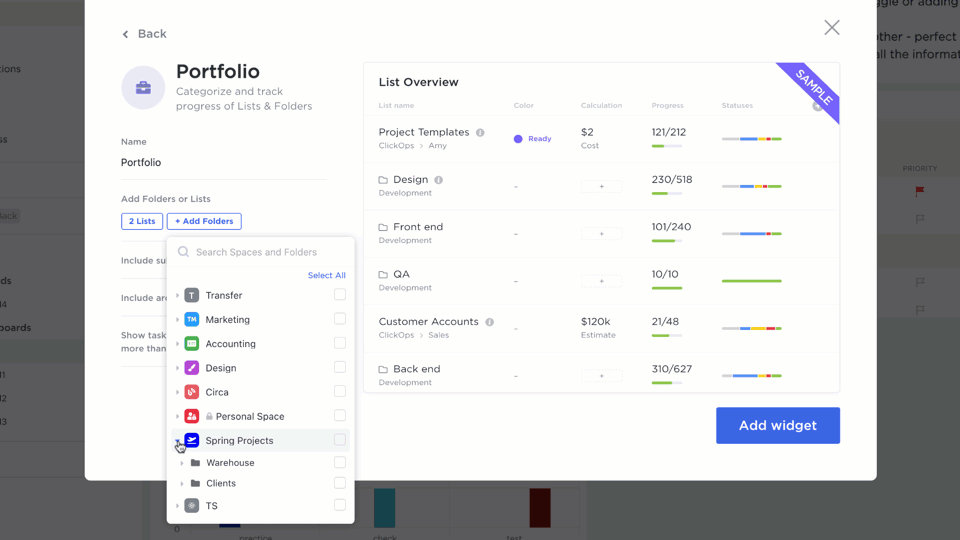
أداة لوحة معلومات المحفظة في ClickUp
جدول المشروع
في أي وقت من الأوقات، ترغب في أن تكون على اطلاع دائم بالتقدم المحرز في مشروعك خاصة فيما يتعلق بحساب الوقت. يمكن استخدام إدارة الوقت ستساعدك الموارد في الحفاظ على تركيزك على المواعيد النهائية وتمرير التواصل مع أعضاء الفريق الآخرين والعملاء بشأن حالة المشروع. أدوات الجدول الزمني للمشروع تتجاوز القلم والورقة والتقويمات التقليدية. يمكنك إنشاء المهام، وتخصيصها في أيام محددة، وتحديد أوقات البدء والانتهاء المتوقعة لها باستخدام التقويم عبر الإنترنت .
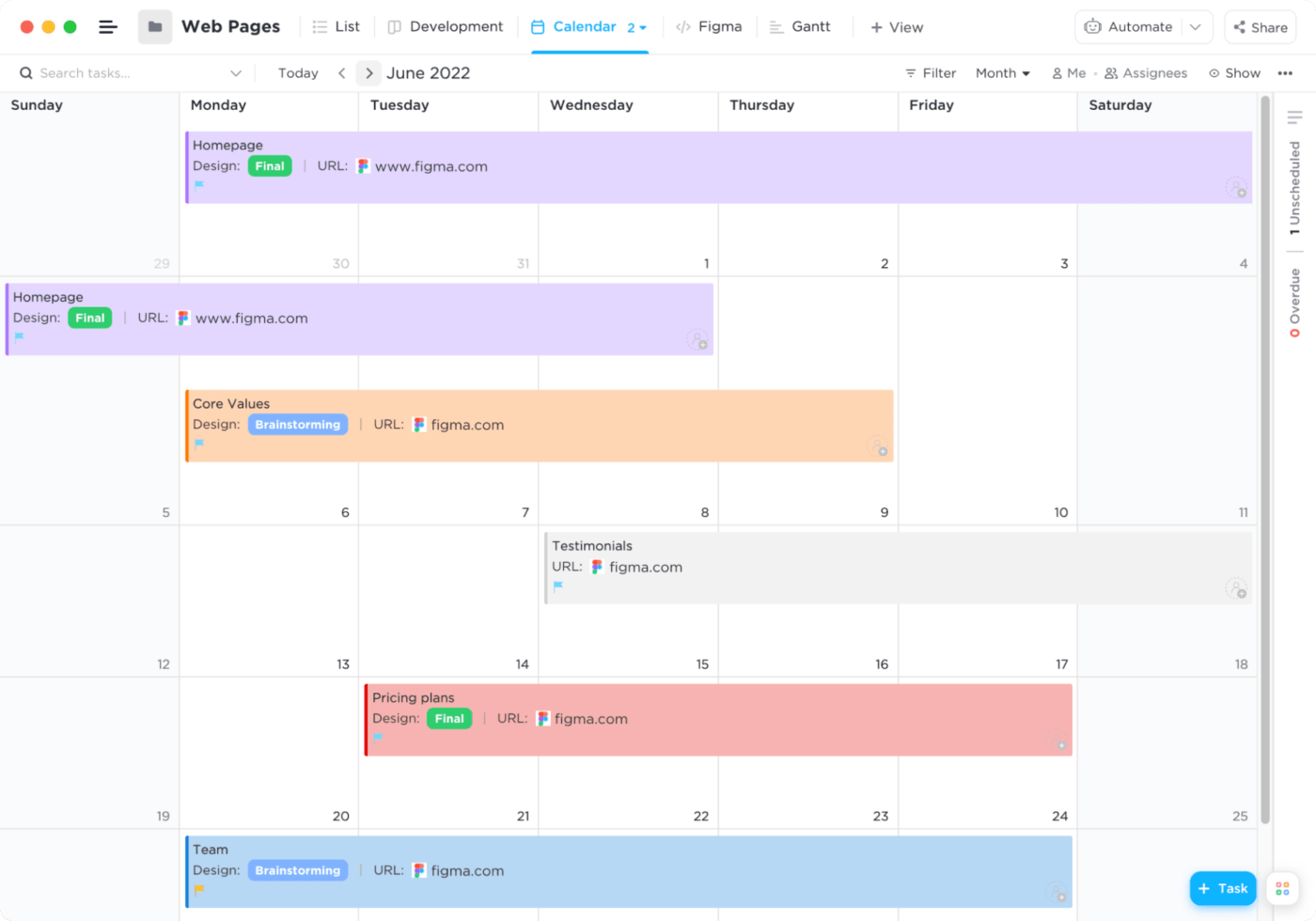
يدعم تقويم المشروع التخطيط والجدولة وإدارة الموارد
نطاق المشروع
قبل بدء المشروع، يجب أن يكون هناك بيان تفصيلي لجميع جوانبه. وهذا البيان هو نطاق المشروع وهو يلتقط جوانب مثل الموارد المطلوبة، والمخرجات، وجميع المهام أو المراحل المتعلقة بالمشروع، والحدود، والجداول الزمنية. إنه مبرر المشروع، ويوثق أهدافه المحددة ومقاييس نجاحه.
أصحاب المصلحة في المشروع
A أصحاب المصلحة في المشروع هو شخص أو مجموعة أو منظمة لها مصلحة في أنشطة المشروع أو تشارك فيها على أي مستوى. هذه الكيانات ستخسر أو تكسب مباشرة من المشروع. يجب على المديرين الجيدين تحديد أصحاب المصلحة وأدوارهم واحتياجاتهم وإبلاغهم بنطاق المشروع.
الجدول الزمني للمشروع
يجب أن يكون للمشروع جدول زمني. ومع ذلك، لا تسير الأمور دائمًا كما هو مخطط لها، وتصيب المشاريع حالات مثل المعالم المتأخرة والتراكمات المتراكمة. A الجدول الزمني للمشروع هو عبارة عن ترتيب زمني للأحداث والمهام الرئيسية للمشروع لضمان سيرها وفقًا للجدول الزمني المحدد. وهو يلتقط وينقل المواعيد النهائية وتبعيات المهام والمهام المحددة والمدد الزمنية المتوقعة للمهام إلى مختلف أصحاب المصلحة.
Q-W: ضمان الجودة لإدارة المشاريع الشلالية
ضمان الجودة
من مصطلحات إدارة المشاريع التي يجب معرفتها ضمان الجودة وهو مبدأ إدارة المشروع الذي يمنع الشركة من تضخيم الأخطاء وتجنب التعرض للمخاطر. فهو يرشد المديرين في تطوير مخرجات الجودة، ووضع معايير للتميز، والتخلص من المزالق. وبالتالي، فإن ضمان الجودة لا يركز على تقديم حزمة كاملة فحسب، بل يركز على تقديم أفضل النتائج في الصناعة للحفاظ على قاعدة العملاء وتنميتها.
إدارة الجودة
يسعى مديرو المشاريع إلى تحقيق التميز ليس كإنجاز لمرة واحدة ولكن كجهد مستمر. تضمن إدارة الجودة تقديم خدمات أو منتجات أو مخرجات أخرى ذات جودة عالية بشكل متسق طوال دورة حياة المشروع. وتشمل خصائصها التي يمكن تحديدها الوظائف والأداء والملاءمة والاتساق والموثوقية. تأتي المنظمة بمعاييرها لقياس هذه المستويات حسب المشروع.
تخطيط الجودة
يساعد هذا الجانب من تخطيط المشروع على تحديد أولويات المشروع. ويحدث ذلك في مرحلة التخطيط ويساعد الفريق والمدير على تحديد الأمور الحاسمة التي تؤدي إلى نجاح المشروع. وهو يسرد الموارد المطلوبة والمهام المعنية والأهداف. بالإضافة إلى ذلك، تحدد هذه الخطوة معايير الجودة التي يجب أن يستوفيها المشروع.
مخطط RACI
A مخطط RACI هو مخطط يحدد مستوى مشاركة الشخص في المشروع، بحيث يفهم الجميع الأدوار والمسؤوليات بوضوح. RACI هو اختصار يرمز إلى مسؤول و خاضع للمساءلة و مستشار و مطلع. يشجع هذا المخطط على التواصل ويحدد الملكية، لذلك فإن الأنشطة في الجدول الزمني للمشروع التحرك وفقًا لذلك دون ارتباك.
تخصيص الموارد
تتطلب إدارة فعالة وذات جودة عالية تخصيص الموارد وهو التموضع الاستراتيجي للموارد المتاحة لدعم المهام المخصصة لها. وهو يؤدي إلى سير المشروع بسلاسة ويحافظ على الإنتاجية ويحافظ على فعالية المشروع من حيث التكلفة. ومع ذلك، يمكن أن يؤثر توافر الموارد وطلبات العميل على تخصيص الموارد.
تخصيص الموارد هي عملية تخصيص مواردك بشكل استراتيجي لتحقيق أهداف المشروع
تسوية الموارد تسوية الموارد هي تقنية إدارية تعمل على تبسيط تخصيص الموارد، ومواءمتها مع الجدول الزمني للمشروع، وفي النهاية التخلص من تخصيص موارد أكثر من اللازم أو غير كافية للمشروع. ومع ذلك، إذا لم يتم القيام به بشكل صحيح، فإن الموارد إما أن تفشل في تقديم الخدمة المثلى للمشروع أو تفشل في الوصول إلى الاستخدام الأمثل لها وبالتالي الهدر. لذلك، يجب التعرف على الثغرات في موارد المشروع، وإجراء تقديرات واقعية للموارد المطلوبة، و
إنشاء قائمة بالأولويات للتعامل مع الموارد والمهام.
إدارة الموارد
تمنح الموارد الحياة للمنظمات والمشاريع، والتي بدونها تواجه بعض الإخفاقات. إدارة الموارد تحافظ على مثل هذه النتائج الوخيمة. فهي تحدد الاستراتيجيات التي ينطوي عليها تخطيط الموارد وترتيبها وتوزيعها. وهي جزء من إدارة المشاريع، وتتحكم في الموارد غير الملموسة والمادية.
إدارة المخاطر
تقوم إدارة المخاطر بتحديد التهديدات المحتملة للمشروعات وتقييمها والتخفيف من حدتها. وتبحث في كيفية تغيير أهداف المشروع ونتائجه بسبب التعرض للمخاطر. توثق العملية المعوقات المتوقعة وطرق التغلب عليها.
زحف النطاق
يُعرّف زحف النطاق بأنه ظاهرة تزداد فيها مخرجات المشروع ومتطلباته مع تقدم المشروع. وهو يضع ضغطًا على الموارد نظرًا لأنه ينطوي على أنشطة خارج نطاق المشروع . مع هذا الضغط الإضافي على الفريق والموارد والوقت، يفقد المشروع اتجاهه ويتعثر أو يفشل.
Scrum
سكروم هو حل إدارة المشاريع الرشيقة الذي يقسم المشاريع إلى أجزاء صغيرة تسمى سباقات السرعة. تستمر سباقات السرعة التكرارية من أسبوعين إلى شهر. ويجمع ملاحظات العملاء في كل سبرنت ويستخدم لوحة سكروم لتوثيق أهداف ومهام السبرنت للحفاظ على وتيرة تسليم المشروع أو تحسينها.
إدارة مشروع سكرم إدارة مشروع سكرم هو خروج عن طريقة إدارة المشاريع التقليدية حيث يشاهد العميل منتج المشروع بعد اكتماله. هذا لا يعطي العميل أي وسيلة لإعطاء ملاحظات قبل الانتهاء من المشروع. أدخل إدارة مشروع Scrum التي تقسم المشروع إلى أدوار، وقطع أثرية، وأحداث.
هذه الثلاثة هي أدوات وأدوار يقسم من خلالها البرنامج مشروعًا معقدًا إلى أجزاء تسمى سباقات السرعة التي تستمر ما بين أسبوعين إلى أربعة أسابيع. في نهاية كل سبرنت، يقدم العميل ملاحظاته لتوجيه فريق الإدارة في تطوير أفضل منتج أو خدمة ممكنة ومرغوبة للعميل.
سبرينت
A السبرينت هي فترة محددة أو ثابتة تستمر بين أسبوع وأربعة أسابيع. وهي دورة تطوير في حياة المشروع. ولذلك، يأتي سبرينت سكروم من تقسيم المشروع إلى مربعات صغيرة أو مهام صغيرة التي تتطلب إكمالها والموافقة عليها من أصحاب المصلحة قبل الانتقال إلى المرحلة التالية.
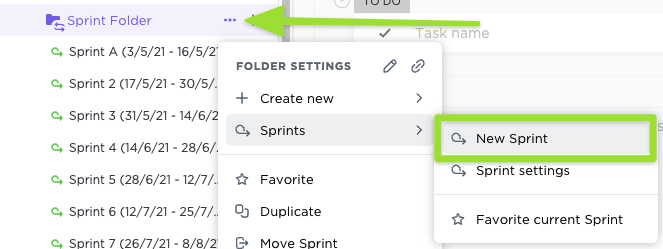
عرض قوائم سبرينت في ClickUp
نقطة القصة
في نهاية سباق السرعة، يقوم الفريق بتعيين وحدات لإعطاء ملاحظات حول الجهد المطلوب لتنفيذ الأعمال المتراكمة لمهمة أو عنصر في المشروع. يقيس هذا المقياس الجانب المجرد من تنفيذ قصة العميل فيما يتعلق بالمخاطر والتعقيدات والجهد المبذول. يتم ذلك في الأعمال المتراكمة للمنتج.
إدارة المشاريع الشلالية
هذا منهجية إدارة المشاريع الخطية تعطي عملية متسلسلة لإكمال المشروع. وهي تتطلب إكمال مرحلة واحدة قبل الانتقال إلى المرحلة التالية، وتتدفق الخطوات أو المراحل أو تتسلسل إلى بعضها البعض مثل المياه التي تنزل إلى أسفل الشلال. قد لا تكون مرنة مثل حلول الإدارة الحديثة، لكنها لا تزال تتبع المراحل المعتادة لإدارة المشروع.
من خلال هذه المصطلحات الخاصة بإدارة المشاريع، ستجد الآن أنه من السهل عليك فهمها وتعظيم الموارد لإخراج أفضل ما لديك من مهام إدارة المشروع . اشترك في النشرة الإخبارية لمدونة ClickUp لمزيد من الأفكار حول إدارة المشاريع والحصول على نصائح عملية مباشرة إلى صندوق الوارد الخاص بك! 📧

